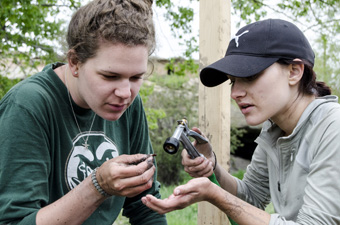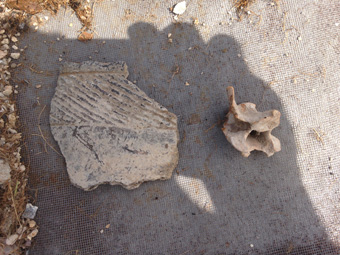During the summer 2015 field season, Dr. Mark Mitchell, Research Director of the Paleocultural Research Group, was asked to run the Department of Anthropology Archaeology Field School with the assistance of Chris Johnston and Julia Kenyon, two graduate students working with Dr. Jason LaBelle, Associate Professor of Archaeology in the Department of Anthropology. The field school offers hands-on training in a variety of archaeological field methods, exposure to differing archaeological sites, and is an opportunity for students to learn valuable life lessons as they live in close quarters and must learn how to work together as a team.

This year, the field school was interested in excavating to the Plano Period with the hope of finding evidence of hunting and camping around 8 kya. Unfortunately, the high water table made block excavation difficult, but the group developed a framework to drain the water away from the unit. The field school’s other goal during this session was to understand the stratigraphic context of artifacts and wanted to provide a straight soil profile for the visiting geoarchaeologist, Rolfe Mandel from the University of Kansas. Dr. Mandel provided important information to aid in understanding the geological processes at Blackfood Cave. Even though this site proved difficult for excavation, the students were able to advance their problem solving skills, learned the basics of block excavation and water screening, and were able to develop a keen eye for flakes, tools, charcoal, bone, and glass.The 2015 course was separated into three sessions at three separate locations. The first session took place at a multi-component site, Blackfoot Cave, in Douglas County Open Space near the Palmer Divide. The Colorado Archaeological Society-Denver Chapter (CAS) has worked on this site for seven years finding evidence of occupation between 10,000-150 years ago. Humans and animals have been attracted to Blackfoot Cave for thousands of years due to the presence of a permanent spring. Archaeological evidence of the Plano Period of the Paleoindian Stage, the Early, Middle, and Late Periods of the Archaic Stage, and the Early and Middle Ceramic Periods of the Late Prehistoric Stage have been found during excavations conducted by CAS.

The students went to Bismarck, North Dakota for the second session of the season to complete block excavation in Chief Looking’s Village, formally known as Ward Village. The Mandan Native American site was an earth lodge settlement overlooking the Missouri River, a prime location for defense of the village. The Archaeology Field School at Colorado State University collaborated with the Archaeology Field School at Minnesota State University Moorhead (MSUM), PCRG members from across the country, faculty from the University of Arkansas, volunteers from Bismarck, the Northern Plains Heritage Foundation, and the North Dakota State Historical Society. Britni Rockwell, senior CSU anthropology major, liked working with the MSUM’s field school and enjoyed that her cohort was able to help and teach the MSUM students the skills and techniques that they had learned in the first session at Blackfoot Cave.
At Chief Looking’s Village the students conducted block excavation, water screening, and magnetometry as well as participated in public outreach. Since the site is in a public park, people that walked by and were interested in the project would be given student-led tours. Andee Dow, senior archaeology major, mentioned that many people walking by the excavation had an interest in what they were doing, immediately became engaged in the tour, and would recall stories about what their past experience has been with archaeology. Some individuals would return a couple days later to see how the project had progressed. Overall, the CSU students enjoyed the two weeks in North Dakota and found the project to be very productive.

For the third and final field session, the group of students for the CSU Archaeology Field School went to Rio Grande National Forest near Del Norte, Colorado. The students completed five days of pedestrian survey and finished up the session in English Valley with shovel testing and dry screening. Most of the pedestrian survey was conducted at 8,000 ft; however, some students went with the National Forest Service above tree line to survey finding flakes, scrapers and a metal projectile point as well as hiked to the top of Mesa Mountain to investigate one of John Fremont’s camps. The students enjoyed the 2015 Archaeology Field School immensely. Brian Alcorn, senior anthropology major, would encourage anyone to participate in the experience, even if archaeology is not their career path, because it was a fun experience that provided skills that are applicable to numerous careers.